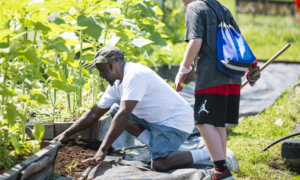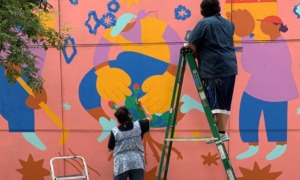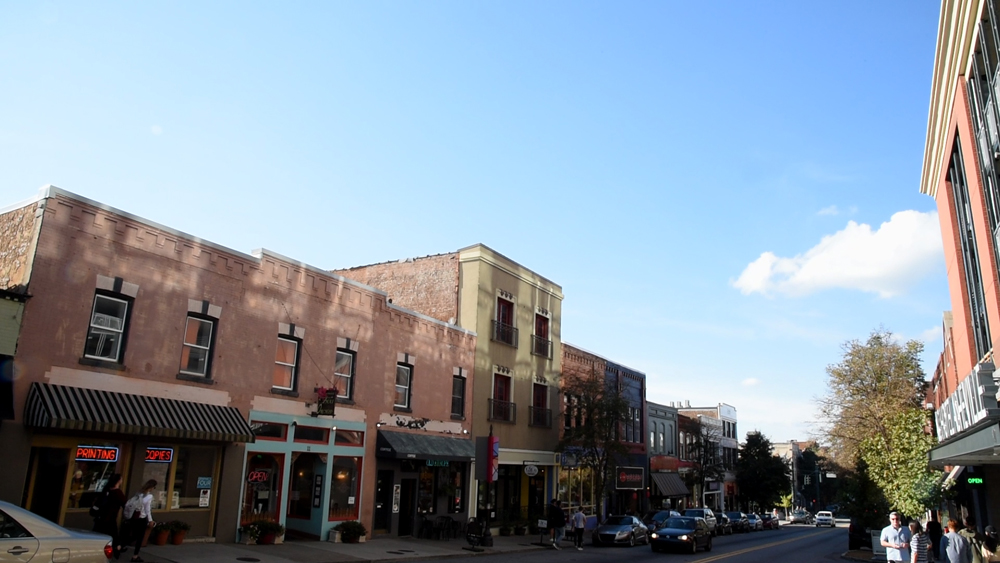
.
This is a continuation of our coverage of homeless youth and the justice system. This month we’re in North Carolina.
ASHEVILLE, N.C. — As thousands of tourists fawn each year over the opulent trappings of western North Carolina’s Biltmore Estates — a four football-field-sized homage to America’s Gilded Age — one of the starkest examples of the nation’s homeless problem endures less than a mile away.
The Tarheel state had nearly 9,000 homeless people in 2017, 20 percent of whom were children under the age of 17, according to the North Carolina Coalition to End Homelessness.
Homeless youth, including those up to the age of 24, are among the fastest-growing segment of North Carolina’s homeless population. And the state’s social services system is working to address the specific challenges of this demographic, which works just as hard to remain under the radar.
Asheville — home to Biltmore Estate — is prime spots for many of those young people. Asheville/Buncombe County has the highest rate of homelessness in North Carolina, according to 2017 data from the North Carolina Coalition to End Homelessness. Buncombe County, for example, has seen an explosion in the number of homeless students in the last 13 years.
[Related: LifeSet Program Teaches Skills Youth in Foster Care Miss]
[Related: Charlotte Nonprofit Raises Private Funds to House Couch-surfing Youth]
Asheville annually draws millions of tourists looking to soak up the mountain air, dine in quaint cafes and browse bohemian art galleries. It has also drawn its share of people who have come to work but have no place to stay. Many wind up on the streets or — if they’re lucky — in a shelter.
The Rev. Amy Cantrell has worked closely with Asheville’s homeless for 17 years. She estimates that on any given day, Asheville has 700 homeless children and young adults. Her assessment provides a more in-the-trenches account of homelessness in Asheville than data from the North Carolina Coalition to End Homelessness, which does an annual one-night, point-in-time count of Asheville’s homelessness. (NCCEH recorded 8,962 homeless in the state during one night on the last week of January in 2017, the most recent available data.)
But, you’d be hard-pressed to find the younger ones.
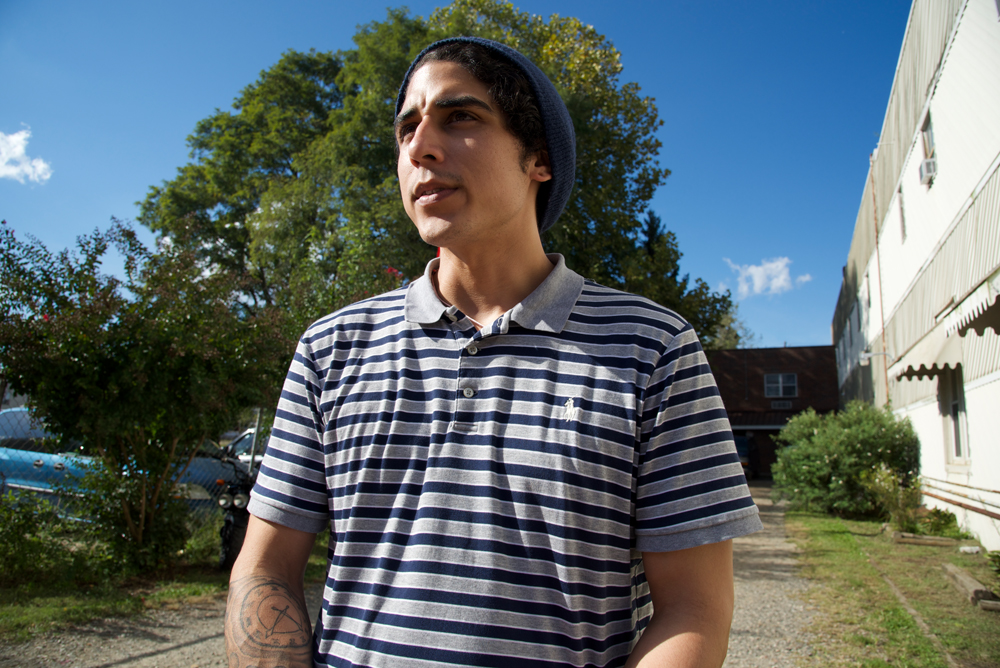
Photo by Roger Newton
Scott DeAngelo, his 22-year-old girlfriend and their 1-year-old daughter ended up at the Western Carolina Rescue Mission after running out of money at a motel.
Many students, young families homeless
Underneath the city’s vibrant economy are sullen socioeconomic realities: The homeless population in Asheville has shifted — women and children now make up the largest share. Compounding the complexity is the fact that homeless youth are considered virtually personae non gratae.
“It’s the most invisible population in terms of homelessness in our community,” said Cantrell, founder of Beloved Asheville, a nonprofit that works with Asheville’s homeless. “You see a little bit of everything. You have LGBTQ kids being kicked out of their homes. Kids running from abusive homes. We’re seeing them in the school systems.”
In fact, the number of homeless students in Buncombe has exploded in the last 13 years. More than 600 homeless students were identified in the Buncombe County school system during the 2017-18 school year, according to county school data. There were less than 30 during the 2005-06 school year.
On Chaos Corner, the locals’ name for a four-way intersection in downtown Asheville filled with boutiques, eateries, art galleries and tourists, Megan Lampe is Hula-Hooping, hoping to get tips. Mostly she gets stares. Chaos is where the homeless like Megan gather. They play music, juggle, read tarot cards or create other entertainment for passing tourists.
Even those like DeWayne Horton who have managed to find work said Asheville can be a tough place.
“Rents are super high right now,” said Horton, who works at The Hookah Hookup in downtown Asheville. “They’re building a lot of apartments and condos that young people can’t afford. I’ve been homeless twice. So I know the experience.”
The 26-year-old Baltimore native once slept in the woods behind an Asheville grocery store where he used to work and lived for a time in a friend’s Geo car. He now has a two-bedroom apartment.
“I’ve got a roof over my head,” Horton said.
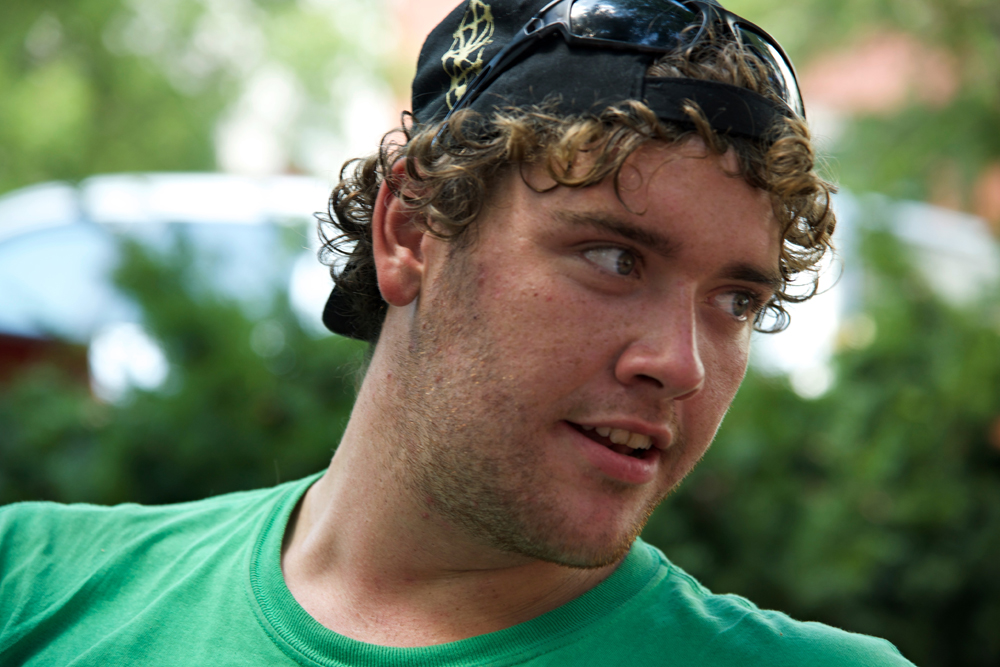
Photo by Roger Newton
Richard “Cornbread” Howard lives on the streets after getting out of rehab.
Many arrests for trespassing
Scott DeAngelo, his 22-year-old girlfriend and their 1-year-old daughter aren’t so fortunate. The young family ended up at the Western Carolina Rescue Mission in Asheville recently after DeAngelo, 28, said a local motel squeezed the last of their money out of them.
When he complained, the clerk responded “We’re a tourist town now.”
“People prey on the most vulnerable,” Cantrell said. “We’re in a severe housing crisis. Our housing costs are exploding in comparison to our wages. Many people are paying 50 percent or more of their income for housing.”
These days, she says she is seeing people, including families, living in their cars and tents, particularly since Asheville has no shelters for single fathers with children. Cantrell recalls seeing a mother and her three children outside the library recently after it had closed for the day. The two older children — elementary and middle-school aged — were playing as their mom sat on the sidewalk charging a tablet. Nearby, their car was packed with belongings.
“We have this all over the community. They blend in,” Cantrell said. “I saw all the possessions in their car. That family would be shut out of a shelter system because she had a son older than 12.”
Such observations led Cantrell to write a piece for the Huffington Post last year on “The Asheville that magazines and travel guides don’t tell you about.”
Asheville, she said, tends to “sweep our struggles under the rug.” Police are constantly on the prowl, she said. When she looked at arrest citations and shelter addresses going back a decade, she found “literally thousands of people” who were cited or arrested for trespassing.
“You’re basically trespassing wherever you go if you’re homeless, and trespassing is making homelessness a crime,” Cantrell said.
Richard “Cornbread” Howard has been living on the streets of Asheville since last year, when a rehab center in Henderson dropped him off and wished him good luck. He stays in Asheville because it has more resources for finding steady places to get free food, he said.
Asheville’s tourism-led building boom has made it the second most gentrified city in the nation. It added 18 new hotels last year alone. Such unrelenting construction illustrates “a stark contrast of wealth and homelessness in Asheville,” Cantrell said.
The Salvation Army sits in the shadows of downtown Asheville’s Hyatt Hotel, where the penthouse goes for $800 a night. Luxury condos called the Patton are across the street from the Western Carolina Rescue Mission, where many of the city’s homeless gather daily for hot meals and showers. Likewise, luxury condos are being built across from Beloved Asheville.
Less than a mile from Beloved is the Biltmore Estates.
“It’s always ironic to me,” Cantrell said. “Here are all these tourists coming to look at this famous house with 200 empty bedrooms and we have people living on the street with nowhere to lay their heads.
“It’s a tale of two cities.”
Editor’s note: This article is made possible in part by support from the Park, Raikes and Tow foundations. Throughout this project, Youth Today will maintain editorial independence.




